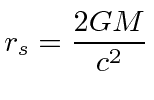Next: Gravity's Effect on Time Up: A Little General Relativity Previous: The Metric Tensor Contents
Schwarzschild solved the Einstein equations under the assumption of spherical symmetry in 1915, two years after their publication. This in itself is a good indication that the equations of General Relativity are a good deal more complicated than Electromagnetism.
The most obvious spherically symmetric problem is that of a point mass. The mass curves space-time and thus affects the particles moving nearby. The metric tensor in Schwarzschild (spherical coordinates becomes

 |
 |
This goes to the normal flat Minkowski space-time interval (in spherical coordinates) for
![]() or for zero mass
or for zero mass
![]() .
.
The Schwarzschild radius for normal planets and stars is much smaller than the actual size of the object so the Schwarzschild solution is only valid outside the object. For black holes, the Schwarzschild radius is the horizon inside of which nothing can escape the black hole.
Jim Branson 2012-10-21